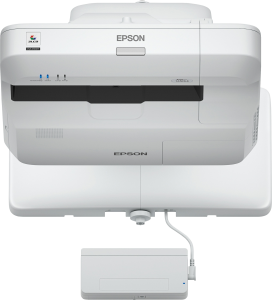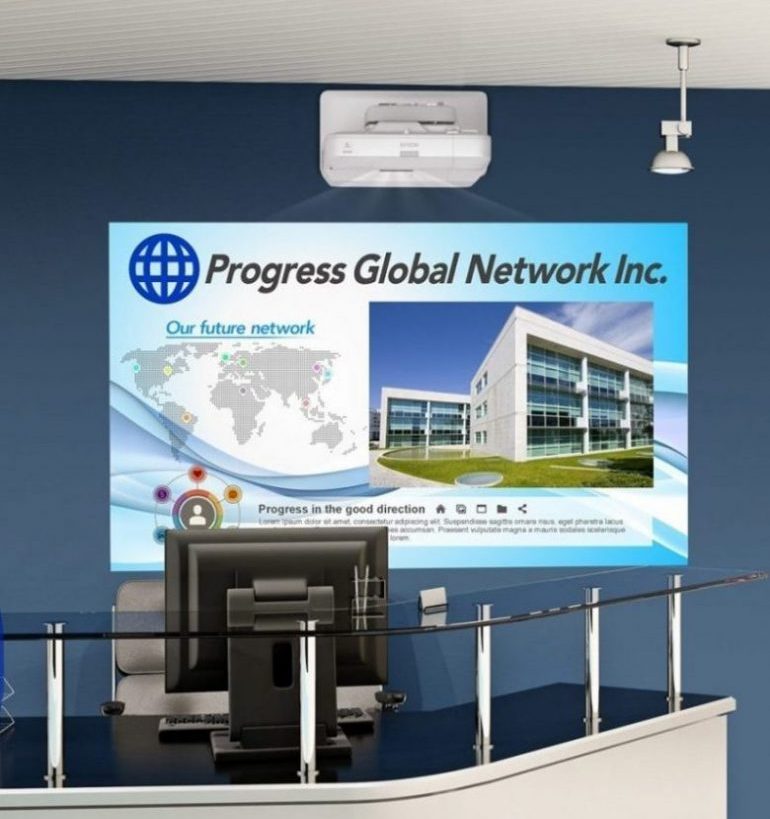Is it time to supersize your interactive display?
Interactive display technology has become a mainstay in the classroom and is an emerging tool in professional settings too, but what options are there when a larger interactive surface area is needed? Interactive flat panels, which are prized for their vivid display, excellent durability and considerable software pairings, can only be built so large. In general, interactive flat panels top out with an 86-inch diagonal, which is sufficient for most applications. But if your classroom or meeting room has the extra real estate, then an EPSON Brightlink projector may be your best bet. The battle between projectors and flat panels remains, but there’s still room for each. A flat panel will usually provide better image quality and superior durability, but a projector can convert many surfaces into an interactive one, and they are a bit less expensive. There is no clear favorite among the two, but there is a definite winner if there’s a need for an extra-large display.Introducing the Brightlink
 EPSON’s Brightlink is a modern interactive display in every sense of the technology. It’s a 3LCD projector, so it operates using the same breakthrough projector technology originally pioneered by EPSON. Brightness, relative to flat panels, is an ongoing concern for projectors, but the Brightlink fares better here than most, with brightness levels that reach 3,400 lumens. At that brightness, there should be no visibility issues and colors will be accurately represented. And because the Brightlink operates using a 3LCD chip, there is no “rainbow” effect and projected images are presented with finer granularity.
What immediately stands out with the Brightlink is its size. With a 100-inch diagonal, the Brightlink can generate an image that no flat panel can manage, and without the considerably upfront cost that is associated with most interactive flat panels.
Although the Brightlink works best when projected onto a whiteboard, it can be used with just about any flat surface. This adds a bit of interesting versatility to the Brightlink, in that it can be used to project onto a table. In this position, students can better collaborate on group work and explore some creative applications, including Promethean’s ActivInspire. The Brightlink supports up to six-point simultaneous touch, so six students can interact with the display at once. Of course, modern flat panels can be arranged in this manner, too, but flat panels are much more cumbersome than a projector. It’s easier to switch a projector from table to wall mode, and back again.
What other features does the Brightlink offer?
EPSON’s Brightlink is a modern interactive display in every sense of the technology. It’s a 3LCD projector, so it operates using the same breakthrough projector technology originally pioneered by EPSON. Brightness, relative to flat panels, is an ongoing concern for projectors, but the Brightlink fares better here than most, with brightness levels that reach 3,400 lumens. At that brightness, there should be no visibility issues and colors will be accurately represented. And because the Brightlink operates using a 3LCD chip, there is no “rainbow” effect and projected images are presented with finer granularity.
What immediately stands out with the Brightlink is its size. With a 100-inch diagonal, the Brightlink can generate an image that no flat panel can manage, and without the considerably upfront cost that is associated with most interactive flat panels.
Although the Brightlink works best when projected onto a whiteboard, it can be used with just about any flat surface. This adds a bit of interesting versatility to the Brightlink, in that it can be used to project onto a table. In this position, students can better collaborate on group work and explore some creative applications, including Promethean’s ActivInspire. The Brightlink supports up to six-point simultaneous touch, so six students can interact with the display at once. Of course, modern flat panels can be arranged in this manner, too, but flat panels are much more cumbersome than a projector. It’s easier to switch a projector from table to wall mode, and back again.
What other features does the Brightlink offer?
1. Wireless connectivity and interactivity – Students and professionals are never caught without their devices, and BYOD is an increasingly popular option for both. The Brightlink can make the most out of BYOD, as up to 15 devices can connect to the projector at once. Once connected, other devices can be used to annotate on the projected image or used to import an image onto the projection. And obviously, anything that is written or imported using the Brightlink will show up on other devices.
Connecting to the Brightlink is simple enough. The teacher or presenter first enables device sharing, and the Brightlink provides a random PIN in response. Other users connect to the Brightlink, input the PIN and they’re ready to go. It’s easy enough that students and professionals should have no trouble with it. With Brightlink’s Moderator mode, teachers can send up to four device screens to the Brightlink at once. This can be used to compare work or to encourage collaboration among groups.
Further, the Brightlink can be linked up with to a laptop using HDMI or VGA. As soon as the laptop is connected, everything on the laptop screen is projected on the board. And the teacher or presenter can interact with their laptop through the Brightlink, effectively turning their 100-inch display into a giant tablet.
2. Video conferencing capabilities – The Brightlink makes for an ideal conferencing platform, as it integrates easily with leading conferencing equipment. For example, the Brightlink can be used to conference with most Polycom systems. If there’s a camera positioned in front of the whiteboard, the user can be a part of the meeting while using the whiteboard. And everyone on the other side can see what is on the whiteboard. The Brightlink user can see the board and the video from the other group at the same time, and with the additional screen space, there’s enough room to view both clearly.
3. Saving and sending whiteboarding sessions – A whiteboarding session can go in any direction, in both a teaching or professional environment. Fortunately, once the meeting or lesson is over, everything on the whiteboard can be saved for future reference or refinement. The whiteboard can also be e-mailed to anyone or printed, so everyone leaves the classroom or meeting room with all notes.
4. Efficient, easy use – Projectors have a reputation for being difficult to handle, but EPSON takes the guesswork out of the equation. The Brightlink comes with automatic calibration, so it can be switched on and used right away. If there are issues with how the picture is arranged, the Brightlink’s Quick Corner feature allows the user to move any corner independently, until the picture is perfect. Finally, the Brightlink’s Instant Off feature means the projector will shut down as soon as it is no longer needed. No cooldown is required.
On the energy efficiency side, the Brightlink is designed with an ECO mode, which operates the projector with a lower brightness setting. There’s also a Light Optimizer Mode, which adjusts the brightness based on the projected image, and an Auto Mode, which adjusts the projector’s brightness based on ambient lighting. There’s also the requisite Sleep Mode to ensure the projector doesn’t burn energy when not in use.
The Brightlink is ideal when you need to go big. It works in nearly any setting and with most surfaces, but no matter where it is used, the Brightlink is an impressive collaborative and teaching tool.


